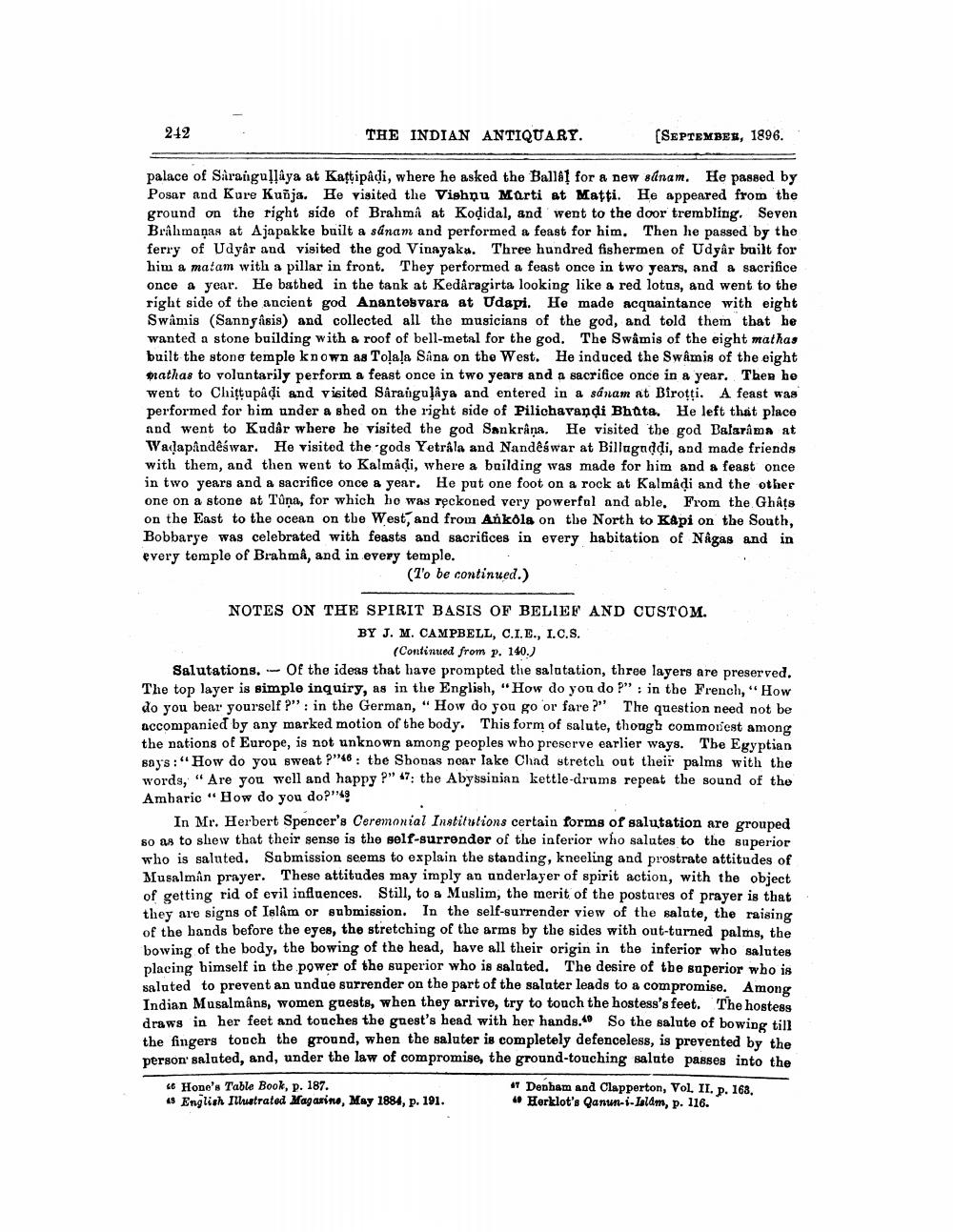________________
212
THE INDIAN ANTIQUARY.
(SEPTEMBER, 1896.
palace of Saraigullâya at Kattipadi, where he asked the Balle! for a new snam. He passed by Posar and Kure Kuõja. Ke visited the Vishnu Marti at Matti. He appeared from the ground on the right side of Brahmî at Kodidal, and went to the door trembling. Seven Brahmaņas at Ajapakke built a sánam and performed a feast for him. Then he passed by the ferry of Udyâr and visited the god Vinayaka. Three hundred fishermen of Udyâr built for him a matam with a pillar in front. They performed a feast once in two years, and a sacrifice once a year. He bathed in the tank at Kedåragirta looking like a red lotus, and went to the right side of the ancient god Anantesvara at Udapi. He made acquaintance with eight Swamis (Sanny asis) and collected all the musicians of the god, and told them that he wanted a stone building with a roof of bell-metal for the god. The Swamis of the eight mathas built the stone temple known as To!a!a Sana on the West. He induced the Swamis of the eight mathas to voluntarily perform a feast once in two years and a sacrifice once in a year. Then he went to Chittupadi and visited Sáranguļâya and entered in a sáram at Birotti. A feast was performed for him under a shed on the right side of Pilichavandi Bhata. He left that place and went to Kudar where he visited the god Sankråna. He visited the god Balarama at Wadapandêswar. He visited the gods Yetrála and Nandêswar at Billagaddi, and made friends with them, and then went to Kalmadi, where a building was made for him and a feast once in two years and a sacrifice once a year. He put one foot on a rock at Kalmádi and the other one on a stone at Túna, for which he was reckoned very powerful and able. From the Ghâts on the East to the ocean on the West, and from Ankols on the North to Kapi on the South, Bobbarye was celebrated with feasts and sacrifices in every habitation of Någas and in every tomple of Brahmâ, and in every temple.
(To be continued.)
NOTES ON THE SPIRIT BASIS OF BELIEF AND CUSTOM.
BY J. M. CAMPBELL, C.I.E., I.C.S.
(Continued from p. 140.) Salutations. Of the ideas that have prompted the salutation, three layers are preserved. The top layer is simple inquiry, as in the English, "How do you do?" : in the French, "How do you bear yourself?": in the German, "How do you go or fare?" The question need not be accompanied by any marked motion of the body. This form of salute, though commouest among the nations of Europe, is not unknown among peoples who preserve earlier ways. The Egyptian says: "How do you sweat?"46: the Shonas near lake Chad stretch out their palms with the words, "Are you well and happy ?" 17: the Abyssinian kettle-drums repeat the sound of the Ambaric "How do you do?!!
In Mr. Herbert Spencer's Ceremonial Institutions certain forms of salutation are grouped so as to slew that their sense is the self-surrender of the inferior who salutes to the superior who is saluted. Submission seems to explain the standing, kneeling and prostrate attitudes of Musalman prayer. These attitudes may imply an underlayer of spirit action, with the object of getting rid of evil influences. Still, to a Muslim, the merit of the postures of prayer is that they are signs of Islâm or submission. In the self-surrender view of the salate, the raising of the hands before the eyes, the stretching of the arms by the sides with out-turned palms, the bowing of the body, the bowing of the head, have all their origin in the inferior who salutes placing himself in the power of the superior who is salated. The desire of the superior who is saluted to prevent an undue surrender on the part of the saluter leads to a compromise. Among Indian Musalmâns, women guests, when they arrive, try to touch the hostess's feet. The hostess draws in her feet and touches the guest's head with her hands. So the salute of bowing till the fingers touch the ground, when the saluter is completely defenceless, is prevented by the person' salated, and, under the law of compromise, the ground-touching salute passes into the * Hone's Table Book, p. 187.
#7 Denham and Clapperton, VOL II. p. 163, 13 English Illustrated Magazine, May 1884, p. 191.
4Herklot's Qanun-i-Lalam, p. 116.




